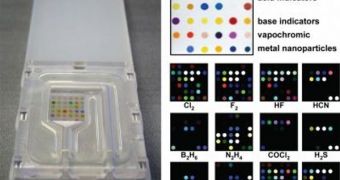An American team of researchers from the University of Illinois (UI), led by the Schmidt Professor of Chemistry, Kenneth Suslick, announce the creation of an electronic nose that is able to sniff out toxic industrial chemicals (TIC), in a fast, effective and cheap manner. In a paper published in the September 13th issue of the journal Nature Chemistry, the team explain that the new instrument works by changing colors when exposed to various types of dangerous chemicals.
“Our device is simply a digital multidimensional extension of litmus paper. We have a six by six array of different nanoporous pigments whose colors change depending on their chemical environment. The pattern of the color change is a unique molecular fingerprint for any toxic gas and also tells us its concentration. By comparing that pattern to a library of color fingerprints, we can identify and quantify the TIC in a matter of seconds,” Suslick explains.
The main advantage that the new device has over others of its type is the fact that it is not influenced by changes in the relative air humidity. The basic component of the array is a series of tiny, colored dots, each with a different hue, which are printed on a substrate such as glass, paper or plastic. Before and after exposure to the environment, the nose is photographed with an average camera, or with a flatbed scanner. The differences in color are then assessed, and the nature of the TIC involved determined.
The National Institutes of Health's (NIH) National Institute of Environmental Health Sciences provided most of the funds for the new experiments. “This research is an essential component of the GEI Exposure Biology Program that NIEHS has the lead on, which is to develop technologies to monitor and better understand how environmental exposures affect disease risk. This paper brings us one step closer to having a small wearable sensor that can detect multiple airborne toxins,” Linda Birnbaum, who is the NIEHS director, shares.
“One of the nice things about this technology is that it uses components that are readily available and relatively inexpensive. Given the broad range of chemicals that can be detected and the high sensitivity of the array to those compounds, it appears that this device will be particularly useful in occupational settings,” NIEHS Program Administrator Davis Balshaw, PhD, concludes.

 14 DAY TRIAL //
14 DAY TRIAL //